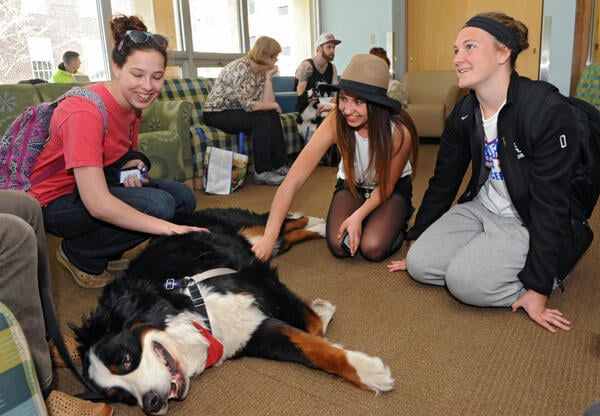
Young people’s mental health is one of the greatest threats to their enrollment, persistence and completion in higher education, and providing holistic supports for well-being and resiliency has been a challenge for administrators.
While greater numbers of students enter college with existing mental health concerns, sometimes the transition to college can present new challenges, particularly for those leaving home for the first time or who are at a college far from their support systems.
A new study from Washington State University evaluated how providing first-year students who left their pets behind when moving to college with unstructured time to interact with dogs can impact their stress and well-being.
Most Popular
Researchers found students reported lower stress and depression levels, compared to their peers who didn’t interact with dogs, as well as greater levels of self-compassion.
The background: For animal lovers, interacting with dogs on campus can provide much-needed stress relief, but most institutions reserve visits from four-legged friends for high-stress times in the year, such as midterms or finals.
Other models do exist, though. Faculty members at Nazareth College provide weekly dog office hours for students to provide stress relief and emotional support throughout the year, and the dogs make regular appearances at campus events.
In addition, previous research has demonstrated therapy dogs can support students’ academic stress by being present in the classroom.
The study: Washington State researchers recruited 147 students who each had a pet at home but not at college. Around 88 percent of participants owned dogs and 49 percent owned cats. All of the participants were first-semester college students and completed a pet-separation-anxiety measure after arriving on campus.
Researchers assessed students’ depression, anxiety, worry, stress, cognitive reappraisal, expressive suppression and self-compassion in pre- and postsurveys.
For their participation in three assessments, students received $5 each, but they did not receive financial incentive to attend the therapy dog sessions, which researchers called PAWs4US.
Of these learners, 77 had access to a seven-session, biweekly two-hour drop-in program for unstructured interactions with therapy dogs. Sixty-eight students were on a wait list control group and had access to one program session at the end of the semester after completing their final survey.
Unstructured time with the dogs involved petting, sitting with or talking to a group of dogs and handlers in an informal environment in a large conference room on campus.
Researchers partnered with nonprofit therapy dog group Palouse Paws to identify human-dog teams for the study, around half of whom had participated in a previous study.
Rover Goes to College
Rather than addressing student homesickness with therapy dogs, some colleges opt to create pet-inclusive spaces on campus, allowing learners to bring their childhood pets with them on their academic journey.
Warren Wilson College created a pet-friendly policy in fall 2024, joining Eckerd College and Stephens College as institutions that consider pets a part of the campus community.
The impact: Those in the trial group reported lower levels of depression, worry and stress at the end of the semester, compared to their peers in the control group. Students who attended PAWs4US regularly, at least three sessions, had more adaptive trajectories compared to their peers.
Over the course of the semester, students who participated in PAWs4US had a slightly downward trajectory for these factors or remained stable, whereas those who didn’t interact with the dogs had worsening symptoms throughout the term.
Students who participated in the drop-in hours with dogs also had higher levels of self-compassion, which may indicate budding resiliency.
Editors’ Picks
Touch was an important factor in the experiment, in part because of the health benefits understood by engaging with animals. But students also shared they missed being able to interact with their pets directly, so the intervention provided space for students to scratch that itch.
The setting of PAWs4US could have also played a role in student stress management.
“It’s likely a combination of sitting quietly, petting the dog, talking to other students and engaging with the handlers that contributes to student well-being,” Patricia Pendry, corresponding author of the study and a WSU professor of human development, said in a university press release.
Do you have a wellness tip that might help others encourage student success? Tell us about it.
This post was originally published on this site be sure to check out more of their content.











































